Cultural Diversity and Work Practice: Personal Reflection and Analysis
VerifiedAdded on 2020/04/15
|10
|2834
|63
Report
AI Summary
This report presents a reflective analysis of the impact of cultural diversity on work practices, drawing from the student's personal background and experiences. The student, born in Australia to parents from Lebanon and Egypt, discusses how their upbringing, including religious beliefs, family traditions, and language, has shaped their understanding of cultural differences. The report explores the challenges faced in an educational setting due to religious discrimination and the difficulties encountered in the workplace due to language barriers. The student reflects on the importance of cultural competence, respect for diverse traditions, and the role of language in fostering a respectful and inclusive work environment. The analysis highlights the importance of understanding cultural humility, recognizing biases, and promoting effective communication to improve patient care and workplace relationships in a multicultural context. The report emphasizes the need for sensitivity and the elimination of discrimination in the workplace.
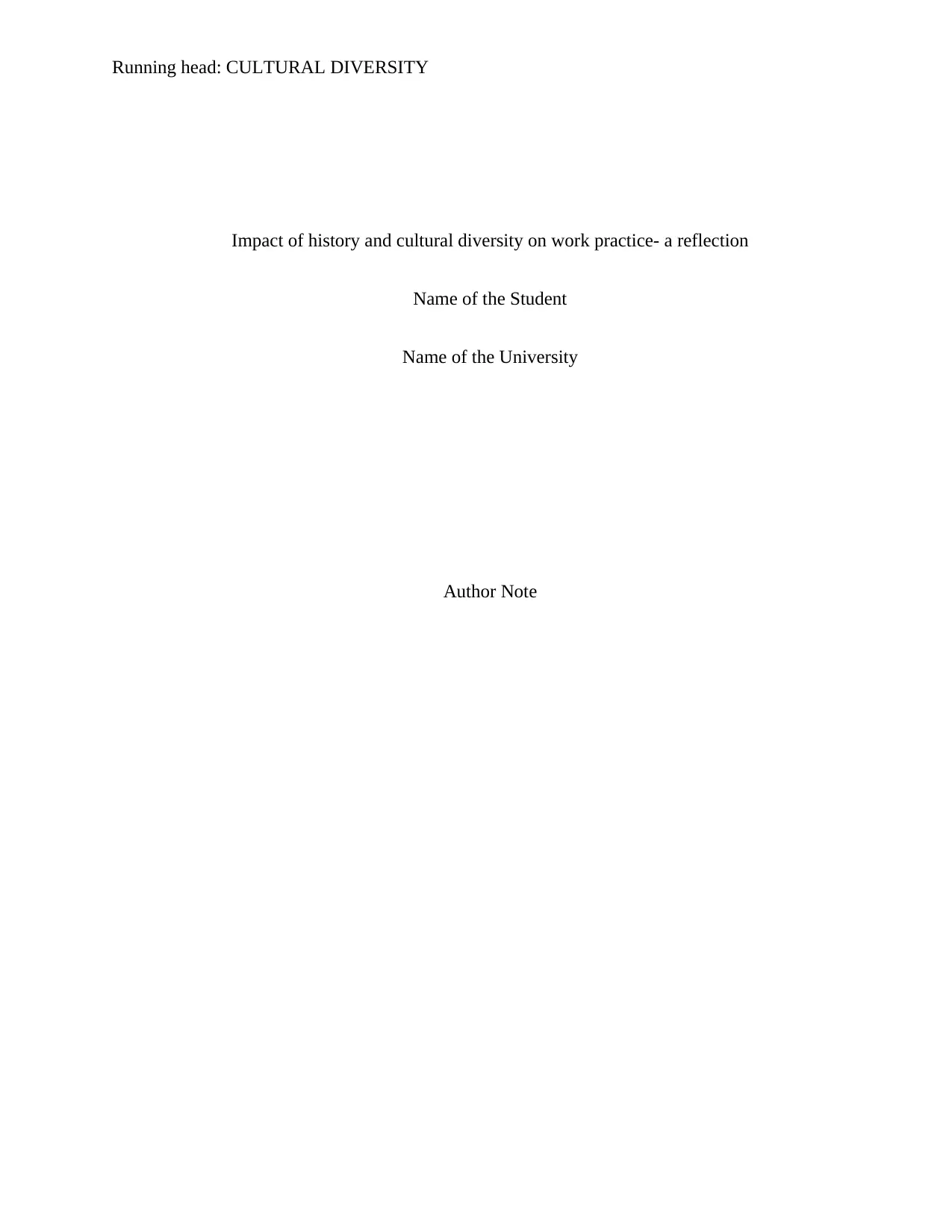
Running head: CULTURAL DIVERSITY
Impact of history and cultural diversity on work practice- a reflection
Name of the Student
Name of the University
Author Note
Impact of history and cultural diversity on work practice- a reflection
Name of the Student
Name of the University
Author Note
Paraphrase This Document
Need a fresh take? Get an instant paraphrase of this document with our AI Paraphraser
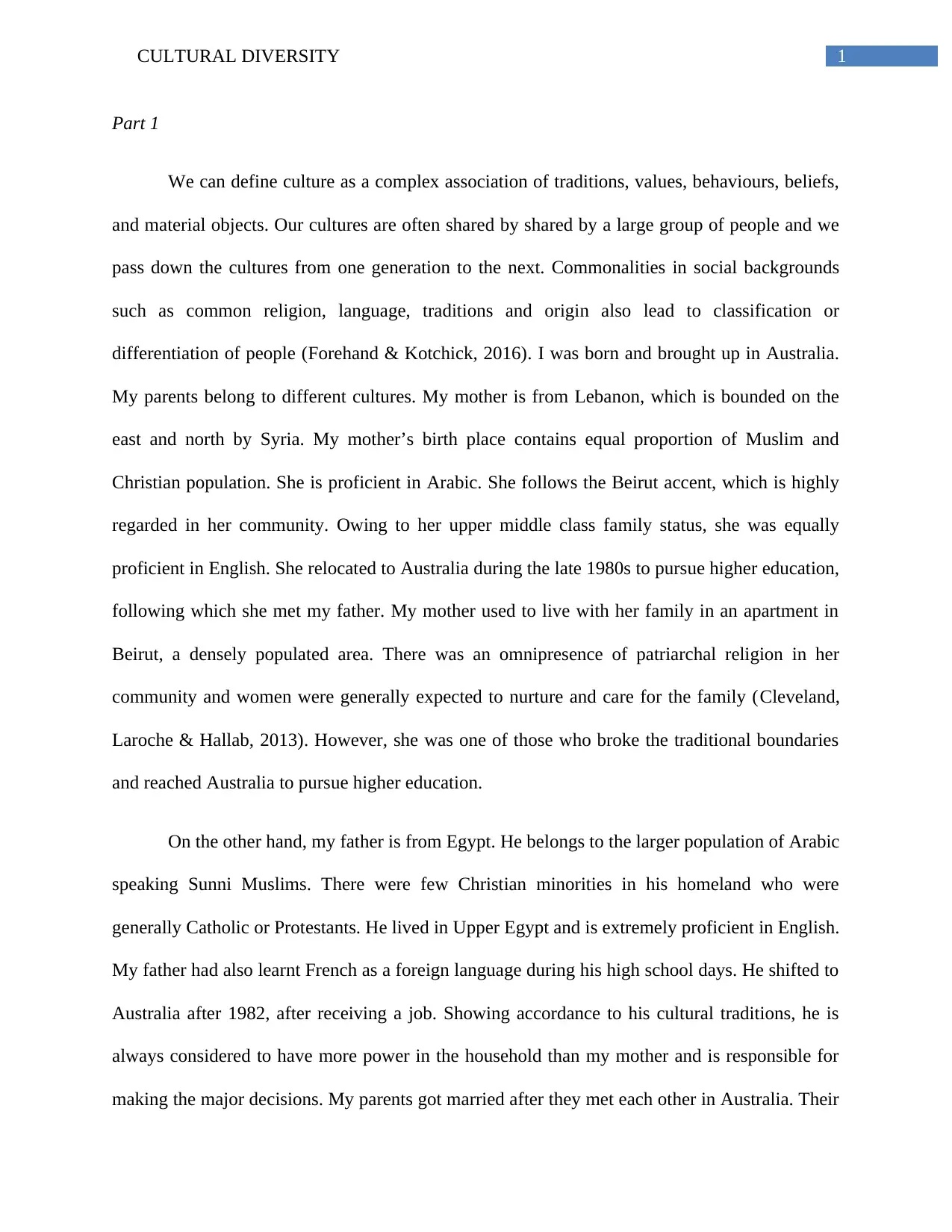
1CULTURAL DIVERSITY
Part 1
We can define culture as a complex association of traditions, values, behaviours, beliefs,
and material objects. Our cultures are often shared by shared by a large group of people and we
pass down the cultures from one generation to the next. Commonalities in social backgrounds
such as common religion, language, traditions and origin also lead to classification or
differentiation of people (Forehand & Kotchick, 2016). I was born and brought up in Australia.
My parents belong to different cultures. My mother is from Lebanon, which is bounded on the
east and north by Syria. My mother’s birth place contains equal proportion of Muslim and
Christian population. She is proficient in Arabic. She follows the Beirut accent, which is highly
regarded in her community. Owing to her upper middle class family status, she was equally
proficient in English. She relocated to Australia during the late 1980s to pursue higher education,
following which she met my father. My mother used to live with her family in an apartment in
Beirut, a densely populated area. There was an omnipresence of patriarchal religion in her
community and women were generally expected to nurture and care for the family (Cleveland,
Laroche & Hallab, 2013). However, she was one of those who broke the traditional boundaries
and reached Australia to pursue higher education.
On the other hand, my father is from Egypt. He belongs to the larger population of Arabic
speaking Sunni Muslims. There were few Christian minorities in his homeland who were
generally Catholic or Protestants. He lived in Upper Egypt and is extremely proficient in English.
My father had also learnt French as a foreign language during his high school days. He shifted to
Australia after 1982, after receiving a job. Showing accordance to his cultural traditions, he is
always considered to have more power in the household than my mother and is responsible for
making the major decisions. My parents got married after they met each other in Australia. Their
Part 1
We can define culture as a complex association of traditions, values, behaviours, beliefs,
and material objects. Our cultures are often shared by shared by a large group of people and we
pass down the cultures from one generation to the next. Commonalities in social backgrounds
such as common religion, language, traditions and origin also lead to classification or
differentiation of people (Forehand & Kotchick, 2016). I was born and brought up in Australia.
My parents belong to different cultures. My mother is from Lebanon, which is bounded on the
east and north by Syria. My mother’s birth place contains equal proportion of Muslim and
Christian population. She is proficient in Arabic. She follows the Beirut accent, which is highly
regarded in her community. Owing to her upper middle class family status, she was equally
proficient in English. She relocated to Australia during the late 1980s to pursue higher education,
following which she met my father. My mother used to live with her family in an apartment in
Beirut, a densely populated area. There was an omnipresence of patriarchal religion in her
community and women were generally expected to nurture and care for the family (Cleveland,
Laroche & Hallab, 2013). However, she was one of those who broke the traditional boundaries
and reached Australia to pursue higher education.
On the other hand, my father is from Egypt. He belongs to the larger population of Arabic
speaking Sunni Muslims. There were few Christian minorities in his homeland who were
generally Catholic or Protestants. He lived in Upper Egypt and is extremely proficient in English.
My father had also learnt French as a foreign language during his high school days. He shifted to
Australia after 1982, after receiving a job. Showing accordance to his cultural traditions, he is
always considered to have more power in the household than my mother and is responsible for
making the major decisions. My parents got married after they met each other in Australia. Their
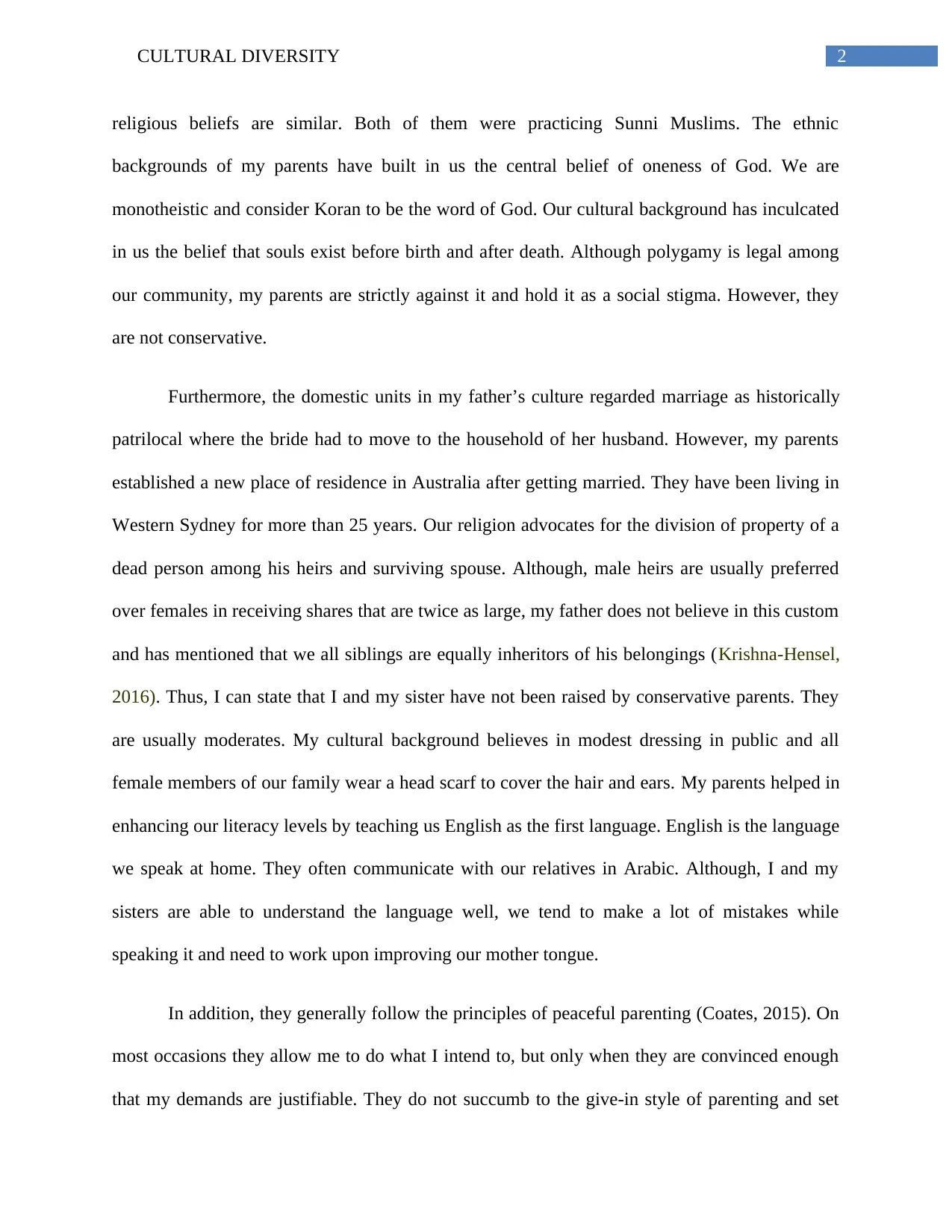
2CULTURAL DIVERSITY
religious beliefs are similar. Both of them were practicing Sunni Muslims. The ethnic
backgrounds of my parents have built in us the central belief of oneness of God. We are
monotheistic and consider Koran to be the word of God. Our cultural background has inculcated
in us the belief that souls exist before birth and after death. Although polygamy is legal among
our community, my parents are strictly against it and hold it as a social stigma. However, they
are not conservative.
Furthermore, the domestic units in my father’s culture regarded marriage as historically
patrilocal where the bride had to move to the household of her husband. However, my parents
established a new place of residence in Australia after getting married. They have been living in
Western Sydney for more than 25 years. Our religion advocates for the division of property of a
dead person among his heirs and surviving spouse. Although, male heirs are usually preferred
over females in receiving shares that are twice as large, my father does not believe in this custom
and has mentioned that we all siblings are equally inheritors of his belongings (Krishna-Hensel,
2016). Thus, I can state that I and my sister have not been raised by conservative parents. They
are usually moderates. My cultural background believes in modest dressing in public and all
female members of our family wear a head scarf to cover the hair and ears. My parents helped in
enhancing our literacy levels by teaching us English as the first language. English is the language
we speak at home. They often communicate with our relatives in Arabic. Although, I and my
sisters are able to understand the language well, we tend to make a lot of mistakes while
speaking it and need to work upon improving our mother tongue.
In addition, they generally follow the principles of peaceful parenting (Coates, 2015). On
most occasions they allow me to do what I intend to, but only when they are convinced enough
that my demands are justifiable. They do not succumb to the give-in style of parenting and set
religious beliefs are similar. Both of them were practicing Sunni Muslims. The ethnic
backgrounds of my parents have built in us the central belief of oneness of God. We are
monotheistic and consider Koran to be the word of God. Our cultural background has inculcated
in us the belief that souls exist before birth and after death. Although polygamy is legal among
our community, my parents are strictly against it and hold it as a social stigma. However, they
are not conservative.
Furthermore, the domestic units in my father’s culture regarded marriage as historically
patrilocal where the bride had to move to the household of her husband. However, my parents
established a new place of residence in Australia after getting married. They have been living in
Western Sydney for more than 25 years. Our religion advocates for the division of property of a
dead person among his heirs and surviving spouse. Although, male heirs are usually preferred
over females in receiving shares that are twice as large, my father does not believe in this custom
and has mentioned that we all siblings are equally inheritors of his belongings (Krishna-Hensel,
2016). Thus, I can state that I and my sister have not been raised by conservative parents. They
are usually moderates. My cultural background believes in modest dressing in public and all
female members of our family wear a head scarf to cover the hair and ears. My parents helped in
enhancing our literacy levels by teaching us English as the first language. English is the language
we speak at home. They often communicate with our relatives in Arabic. Although, I and my
sisters are able to understand the language well, we tend to make a lot of mistakes while
speaking it and need to work upon improving our mother tongue.
In addition, they generally follow the principles of peaceful parenting (Coates, 2015). On
most occasions they allow me to do what I intend to, but only when they are convinced enough
that my demands are justifiable. They do not succumb to the give-in style of parenting and set
⊘ This is a preview!⊘
Do you want full access?
Subscribe today to unlock all pages.

Trusted by 1+ million students worldwide
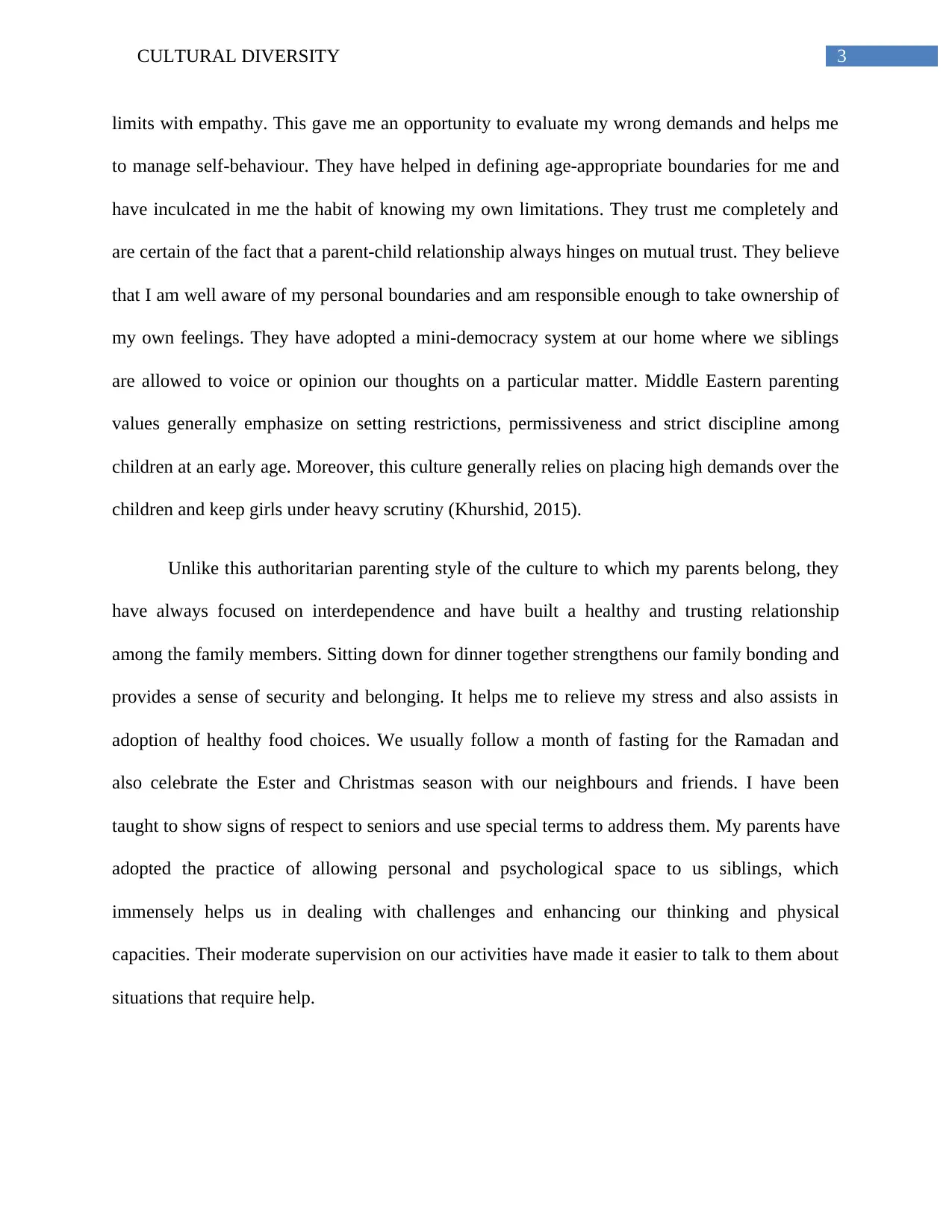
3CULTURAL DIVERSITY
limits with empathy. This gave me an opportunity to evaluate my wrong demands and helps me
to manage self-behaviour. They have helped in defining age-appropriate boundaries for me and
have inculcated in me the habit of knowing my own limitations. They trust me completely and
are certain of the fact that a parent-child relationship always hinges on mutual trust. They believe
that I am well aware of my personal boundaries and am responsible enough to take ownership of
my own feelings. They have adopted a mini-democracy system at our home where we siblings
are allowed to voice or opinion our thoughts on a particular matter. Middle Eastern parenting
values generally emphasize on setting restrictions, permissiveness and strict discipline among
children at an early age. Moreover, this culture generally relies on placing high demands over the
children and keep girls under heavy scrutiny (Khurshid, 2015).
Unlike this authoritarian parenting style of the culture to which my parents belong, they
have always focused on interdependence and have built a healthy and trusting relationship
among the family members. Sitting down for dinner together strengthens our family bonding and
provides a sense of security and belonging. It helps me to relieve my stress and also assists in
adoption of healthy food choices. We usually follow a month of fasting for the Ramadan and
also celebrate the Ester and Christmas season with our neighbours and friends. I have been
taught to show signs of respect to seniors and use special terms to address them. My parents have
adopted the practice of allowing personal and psychological space to us siblings, which
immensely helps us in dealing with challenges and enhancing our thinking and physical
capacities. Their moderate supervision on our activities have made it easier to talk to them about
situations that require help.
limits with empathy. This gave me an opportunity to evaluate my wrong demands and helps me
to manage self-behaviour. They have helped in defining age-appropriate boundaries for me and
have inculcated in me the habit of knowing my own limitations. They trust me completely and
are certain of the fact that a parent-child relationship always hinges on mutual trust. They believe
that I am well aware of my personal boundaries and am responsible enough to take ownership of
my own feelings. They have adopted a mini-democracy system at our home where we siblings
are allowed to voice or opinion our thoughts on a particular matter. Middle Eastern parenting
values generally emphasize on setting restrictions, permissiveness and strict discipline among
children at an early age. Moreover, this culture generally relies on placing high demands over the
children and keep girls under heavy scrutiny (Khurshid, 2015).
Unlike this authoritarian parenting style of the culture to which my parents belong, they
have always focused on interdependence and have built a healthy and trusting relationship
among the family members. Sitting down for dinner together strengthens our family bonding and
provides a sense of security and belonging. It helps me to relieve my stress and also assists in
adoption of healthy food choices. We usually follow a month of fasting for the Ramadan and
also celebrate the Ester and Christmas season with our neighbours and friends. I have been
taught to show signs of respect to seniors and use special terms to address them. My parents have
adopted the practice of allowing personal and psychological space to us siblings, which
immensely helps us in dealing with challenges and enhancing our thinking and physical
capacities. Their moderate supervision on our activities have made it easier to talk to them about
situations that require help.
Paraphrase This Document
Need a fresh take? Get an instant paraphrase of this document with our AI Paraphraser
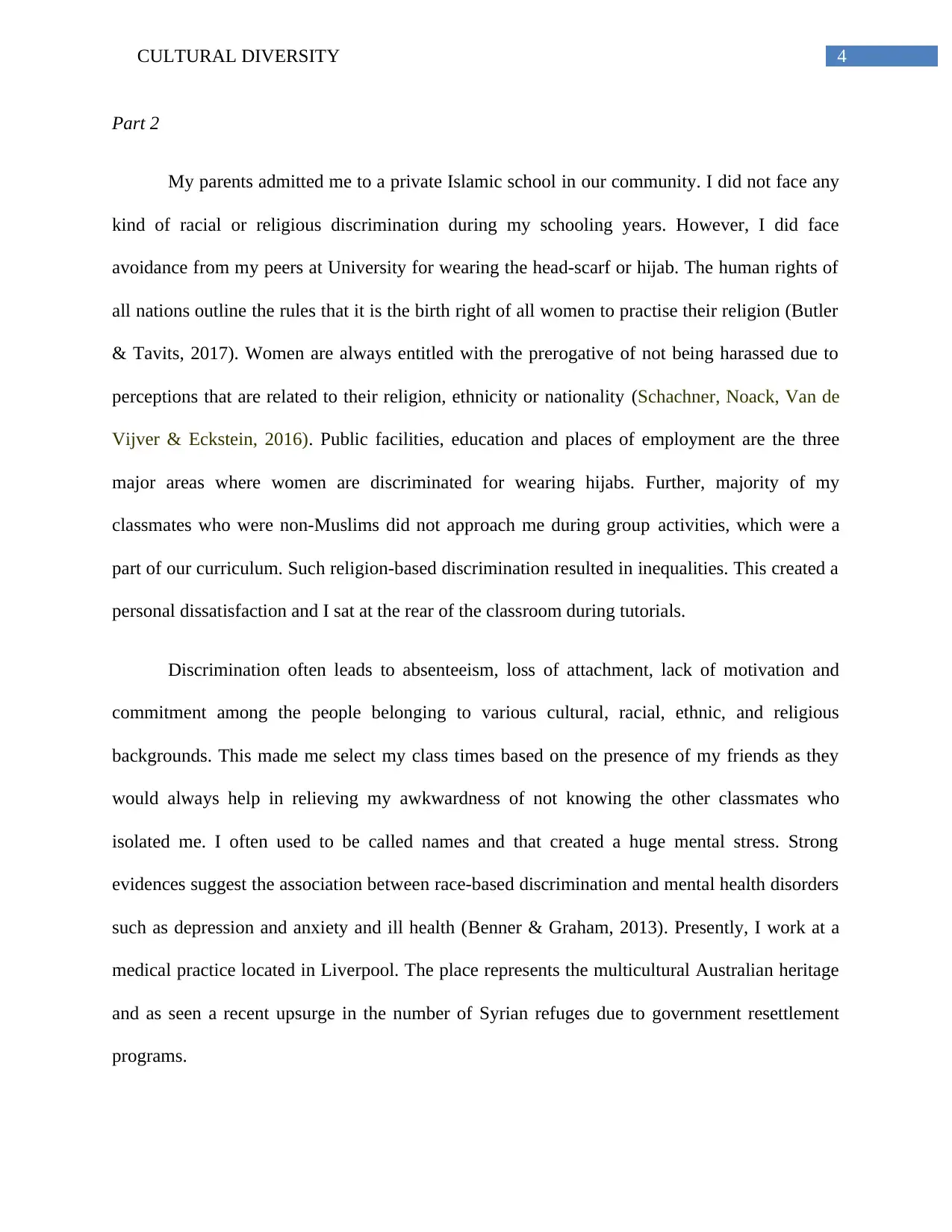
4CULTURAL DIVERSITY
Part 2
My parents admitted me to a private Islamic school in our community. I did not face any
kind of racial or religious discrimination during my schooling years. However, I did face
avoidance from my peers at University for wearing the head-scarf or hijab. The human rights of
all nations outline the rules that it is the birth right of all women to practise their religion (Butler
& Tavits, 2017). Women are always entitled with the prerogative of not being harassed due to
perceptions that are related to their religion, ethnicity or nationality (Schachner, Noack, Van de
Vijver & Eckstein, 2016). Public facilities, education and places of employment are the three
major areas where women are discriminated for wearing hijabs. Further, majority of my
classmates who were non-Muslims did not approach me during group activities, which were a
part of our curriculum. Such religion-based discrimination resulted in inequalities. This created a
personal dissatisfaction and I sat at the rear of the classroom during tutorials.
Discrimination often leads to absenteeism, loss of attachment, lack of motivation and
commitment among the people belonging to various cultural, racial, ethnic, and religious
backgrounds. This made me select my class times based on the presence of my friends as they
would always help in relieving my awkwardness of not knowing the other classmates who
isolated me. I often used to be called names and that created a huge mental stress. Strong
evidences suggest the association between race-based discrimination and mental health disorders
such as depression and anxiety and ill health (Benner & Graham, 2013). Presently, I work at a
medical practice located in Liverpool. The place represents the multicultural Australian heritage
and as seen a recent upsurge in the number of Syrian refuges due to government resettlement
programs.
Part 2
My parents admitted me to a private Islamic school in our community. I did not face any
kind of racial or religious discrimination during my schooling years. However, I did face
avoidance from my peers at University for wearing the head-scarf or hijab. The human rights of
all nations outline the rules that it is the birth right of all women to practise their religion (Butler
& Tavits, 2017). Women are always entitled with the prerogative of not being harassed due to
perceptions that are related to their religion, ethnicity or nationality (Schachner, Noack, Van de
Vijver & Eckstein, 2016). Public facilities, education and places of employment are the three
major areas where women are discriminated for wearing hijabs. Further, majority of my
classmates who were non-Muslims did not approach me during group activities, which were a
part of our curriculum. Such religion-based discrimination resulted in inequalities. This created a
personal dissatisfaction and I sat at the rear of the classroom during tutorials.
Discrimination often leads to absenteeism, loss of attachment, lack of motivation and
commitment among the people belonging to various cultural, racial, ethnic, and religious
backgrounds. This made me select my class times based on the presence of my friends as they
would always help in relieving my awkwardness of not knowing the other classmates who
isolated me. I often used to be called names and that created a huge mental stress. Strong
evidences suggest the association between race-based discrimination and mental health disorders
such as depression and anxiety and ill health (Benner & Graham, 2013). Presently, I work at a
medical practice located in Liverpool. The place represents the multicultural Australian heritage
and as seen a recent upsurge in the number of Syrian refuges due to government resettlement
programs.
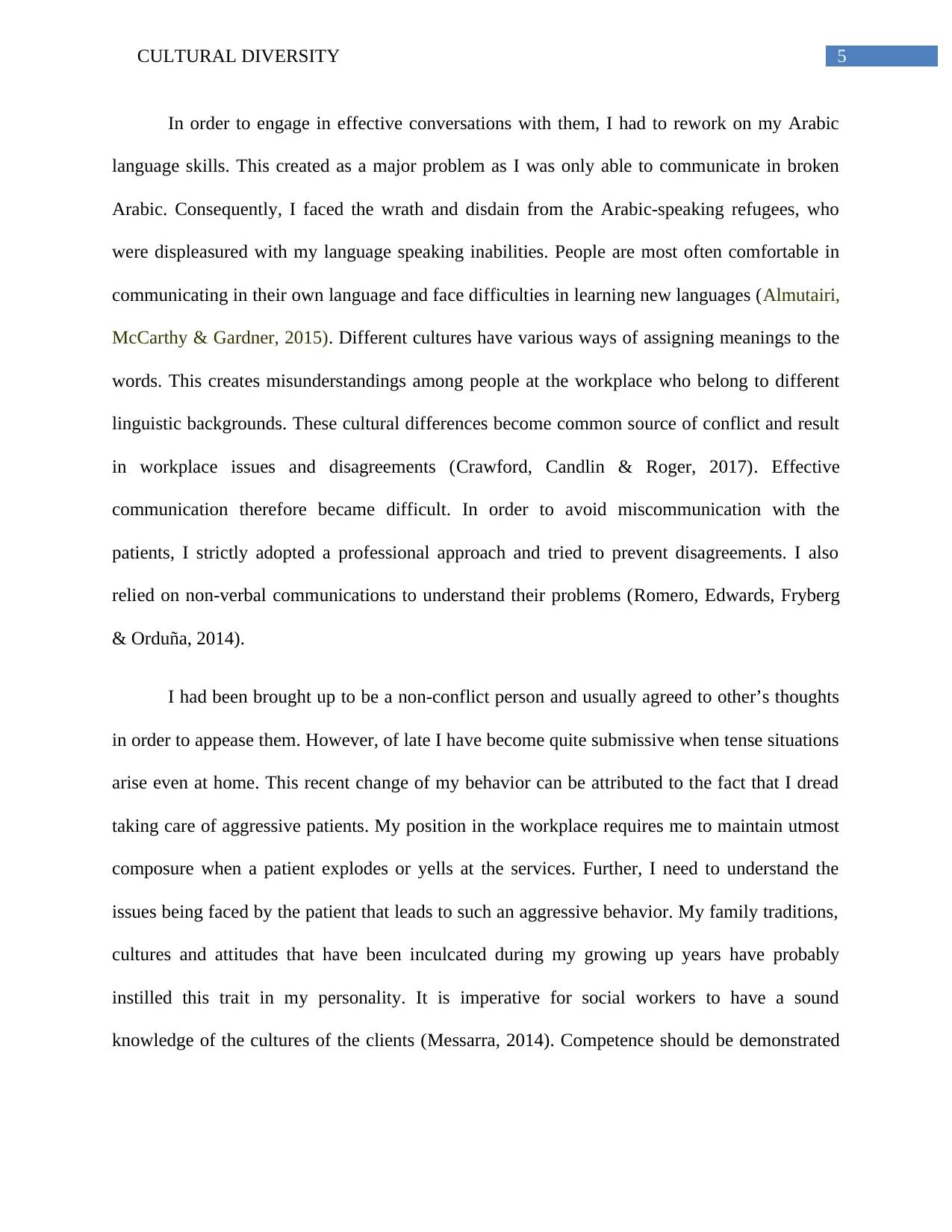
5CULTURAL DIVERSITY
In order to engage in effective conversations with them, I had to rework on my Arabic
language skills. This created as a major problem as I was only able to communicate in broken
Arabic. Consequently, I faced the wrath and disdain from the Arabic-speaking refugees, who
were displeasured with my language speaking inabilities. People are most often comfortable in
communicating in their own language and face difficulties in learning new languages (Almutairi,
McCarthy & Gardner, 2015). Different cultures have various ways of assigning meanings to the
words. This creates misunderstandings among people at the workplace who belong to different
linguistic backgrounds. These cultural differences become common source of conflict and result
in workplace issues and disagreements (Crawford, Candlin & Roger, 2017). Effective
communication therefore became difficult. In order to avoid miscommunication with the
patients, I strictly adopted a professional approach and tried to prevent disagreements. I also
relied on non-verbal communications to understand their problems (Romero, Edwards, Fryberg
& Orduña, 2014).
I had been brought up to be a non-conflict person and usually agreed to other’s thoughts
in order to appease them. However, of late I have become quite submissive when tense situations
arise even at home. This recent change of my behavior can be attributed to the fact that I dread
taking care of aggressive patients. My position in the workplace requires me to maintain utmost
composure when a patient explodes or yells at the services. Further, I need to understand the
issues being faced by the patient that leads to such an aggressive behavior. My family traditions,
cultures and attitudes that have been inculcated during my growing up years have probably
instilled this trait in my personality. It is imperative for social workers to have a sound
knowledge of the cultures of the clients (Messarra, 2014). Competence should be demonstrated
In order to engage in effective conversations with them, I had to rework on my Arabic
language skills. This created as a major problem as I was only able to communicate in broken
Arabic. Consequently, I faced the wrath and disdain from the Arabic-speaking refugees, who
were displeasured with my language speaking inabilities. People are most often comfortable in
communicating in their own language and face difficulties in learning new languages (Almutairi,
McCarthy & Gardner, 2015). Different cultures have various ways of assigning meanings to the
words. This creates misunderstandings among people at the workplace who belong to different
linguistic backgrounds. These cultural differences become common source of conflict and result
in workplace issues and disagreements (Crawford, Candlin & Roger, 2017). Effective
communication therefore became difficult. In order to avoid miscommunication with the
patients, I strictly adopted a professional approach and tried to prevent disagreements. I also
relied on non-verbal communications to understand their problems (Romero, Edwards, Fryberg
& Orduña, 2014).
I had been brought up to be a non-conflict person and usually agreed to other’s thoughts
in order to appease them. However, of late I have become quite submissive when tense situations
arise even at home. This recent change of my behavior can be attributed to the fact that I dread
taking care of aggressive patients. My position in the workplace requires me to maintain utmost
composure when a patient explodes or yells at the services. Further, I need to understand the
issues being faced by the patient that leads to such an aggressive behavior. My family traditions,
cultures and attitudes that have been inculcated during my growing up years have probably
instilled this trait in my personality. It is imperative for social workers to have a sound
knowledge of the cultures of the clients (Messarra, 2014). Competence should be demonstrated
⊘ This is a preview!⊘
Do you want full access?
Subscribe today to unlock all pages.

Trusted by 1+ million students worldwide
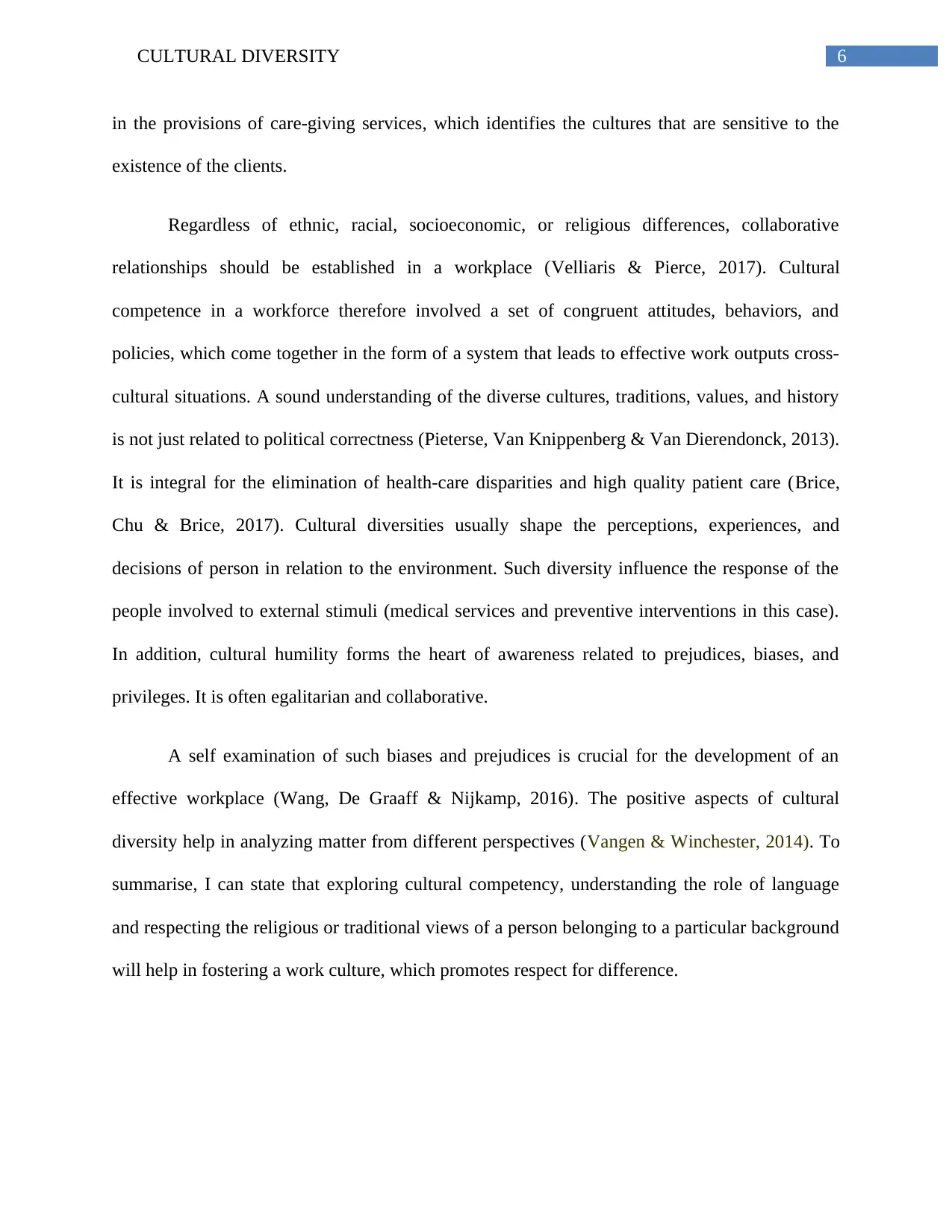
6CULTURAL DIVERSITY
in the provisions of care-giving services, which identifies the cultures that are sensitive to the
existence of the clients.
Regardless of ethnic, racial, socioeconomic, or religious differences, collaborative
relationships should be established in a workplace (Velliaris & Pierce, 2017). Cultural
competence in a workforce therefore involved a set of congruent attitudes, behaviors, and
policies, which come together in the form of a system that leads to effective work outputs cross-
cultural situations. A sound understanding of the diverse cultures, traditions, values, and history
is not just related to political correctness (Pieterse, Van Knippenberg & Van Dierendonck, 2013).
It is integral for the elimination of health-care disparities and high quality patient care (Brice,
Chu & Brice, 2017). Cultural diversities usually shape the perceptions, experiences, and
decisions of person in relation to the environment. Such diversity influence the response of the
people involved to external stimuli (medical services and preventive interventions in this case).
In addition, cultural humility forms the heart of awareness related to prejudices, biases, and
privileges. It is often egalitarian and collaborative.
A self examination of such biases and prejudices is crucial for the development of an
effective workplace (Wang, De Graaff & Nijkamp, 2016). The positive aspects of cultural
diversity help in analyzing matter from different perspectives (Vangen & Winchester, 2014). To
summarise, I can state that exploring cultural competency, understanding the role of language
and respecting the religious or traditional views of a person belonging to a particular background
will help in fostering a work culture, which promotes respect for difference.
in the provisions of care-giving services, which identifies the cultures that are sensitive to the
existence of the clients.
Regardless of ethnic, racial, socioeconomic, or religious differences, collaborative
relationships should be established in a workplace (Velliaris & Pierce, 2017). Cultural
competence in a workforce therefore involved a set of congruent attitudes, behaviors, and
policies, which come together in the form of a system that leads to effective work outputs cross-
cultural situations. A sound understanding of the diverse cultures, traditions, values, and history
is not just related to political correctness (Pieterse, Van Knippenberg & Van Dierendonck, 2013).
It is integral for the elimination of health-care disparities and high quality patient care (Brice,
Chu & Brice, 2017). Cultural diversities usually shape the perceptions, experiences, and
decisions of person in relation to the environment. Such diversity influence the response of the
people involved to external stimuli (medical services and preventive interventions in this case).
In addition, cultural humility forms the heart of awareness related to prejudices, biases, and
privileges. It is often egalitarian and collaborative.
A self examination of such biases and prejudices is crucial for the development of an
effective workplace (Wang, De Graaff & Nijkamp, 2016). The positive aspects of cultural
diversity help in analyzing matter from different perspectives (Vangen & Winchester, 2014). To
summarise, I can state that exploring cultural competency, understanding the role of language
and respecting the religious or traditional views of a person belonging to a particular background
will help in fostering a work culture, which promotes respect for difference.
Paraphrase This Document
Need a fresh take? Get an instant paraphrase of this document with our AI Paraphraser
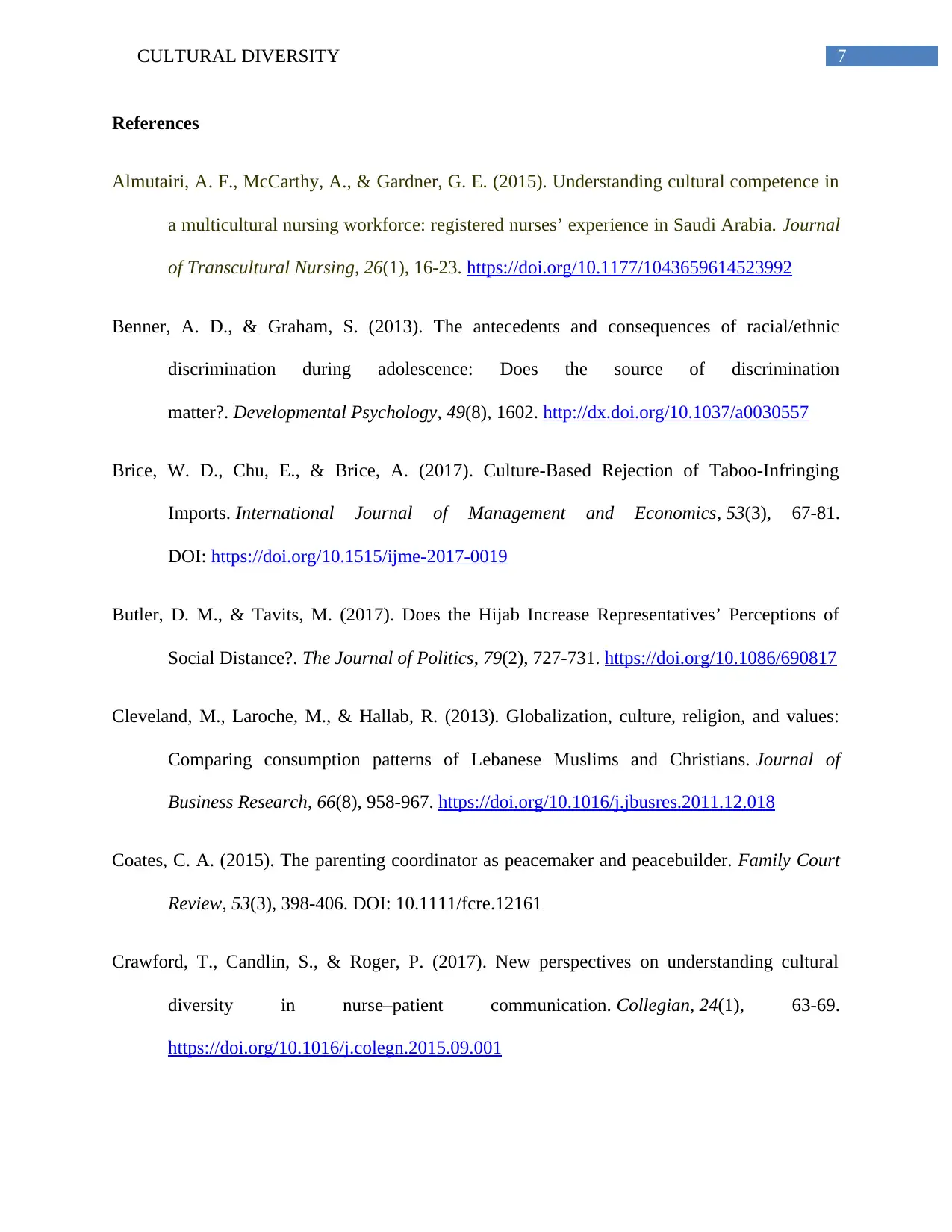
7CULTURAL DIVERSITY
References
Almutairi, A. F., McCarthy, A., & Gardner, G. E. (2015). Understanding cultural competence in
a multicultural nursing workforce: registered nurses’ experience in Saudi Arabia. Journal
of Transcultural Nursing, 26(1), 16-23. https://doi.org/10.1177/1043659614523992
Benner, A. D., & Graham, S. (2013). The antecedents and consequences of racial/ethnic
discrimination during adolescence: Does the source of discrimination
matter?. Developmental Psychology, 49(8), 1602. http://dx.doi.org/10.1037/a0030557
Brice, W. D., Chu, E., & Brice, A. (2017). Culture-Based Rejection of Taboo-Infringing
Imports. International Journal of Management and Economics, 53(3), 67-81.
DOI: https://doi.org/10.1515/ijme-2017-0019
Butler, D. M., & Tavits, M. (2017). Does the Hijab Increase Representatives’ Perceptions of
Social Distance?. The Journal of Politics, 79(2), 727-731. https://doi.org/10.1086/690817
Cleveland, M., Laroche, M., & Hallab, R. (2013). Globalization, culture, religion, and values:
Comparing consumption patterns of Lebanese Muslims and Christians. Journal of
Business Research, 66(8), 958-967. https://doi.org/10.1016/j.jbusres.2011.12.018
Coates, C. A. (2015). The parenting coordinator as peacemaker and peacebuilder. Family Court
Review, 53(3), 398-406. DOI: 10.1111/fcre.12161
Crawford, T., Candlin, S., & Roger, P. (2017). New perspectives on understanding cultural
diversity in nurse–patient communication. Collegian, 24(1), 63-69.
https://doi.org/10.1016/j.colegn.2015.09.001
References
Almutairi, A. F., McCarthy, A., & Gardner, G. E. (2015). Understanding cultural competence in
a multicultural nursing workforce: registered nurses’ experience in Saudi Arabia. Journal
of Transcultural Nursing, 26(1), 16-23. https://doi.org/10.1177/1043659614523992
Benner, A. D., & Graham, S. (2013). The antecedents and consequences of racial/ethnic
discrimination during adolescence: Does the source of discrimination
matter?. Developmental Psychology, 49(8), 1602. http://dx.doi.org/10.1037/a0030557
Brice, W. D., Chu, E., & Brice, A. (2017). Culture-Based Rejection of Taboo-Infringing
Imports. International Journal of Management and Economics, 53(3), 67-81.
DOI: https://doi.org/10.1515/ijme-2017-0019
Butler, D. M., & Tavits, M. (2017). Does the Hijab Increase Representatives’ Perceptions of
Social Distance?. The Journal of Politics, 79(2), 727-731. https://doi.org/10.1086/690817
Cleveland, M., Laroche, M., & Hallab, R. (2013). Globalization, culture, religion, and values:
Comparing consumption patterns of Lebanese Muslims and Christians. Journal of
Business Research, 66(8), 958-967. https://doi.org/10.1016/j.jbusres.2011.12.018
Coates, C. A. (2015). The parenting coordinator as peacemaker and peacebuilder. Family Court
Review, 53(3), 398-406. DOI: 10.1111/fcre.12161
Crawford, T., Candlin, S., & Roger, P. (2017). New perspectives on understanding cultural
diversity in nurse–patient communication. Collegian, 24(1), 63-69.
https://doi.org/10.1016/j.colegn.2015.09.001
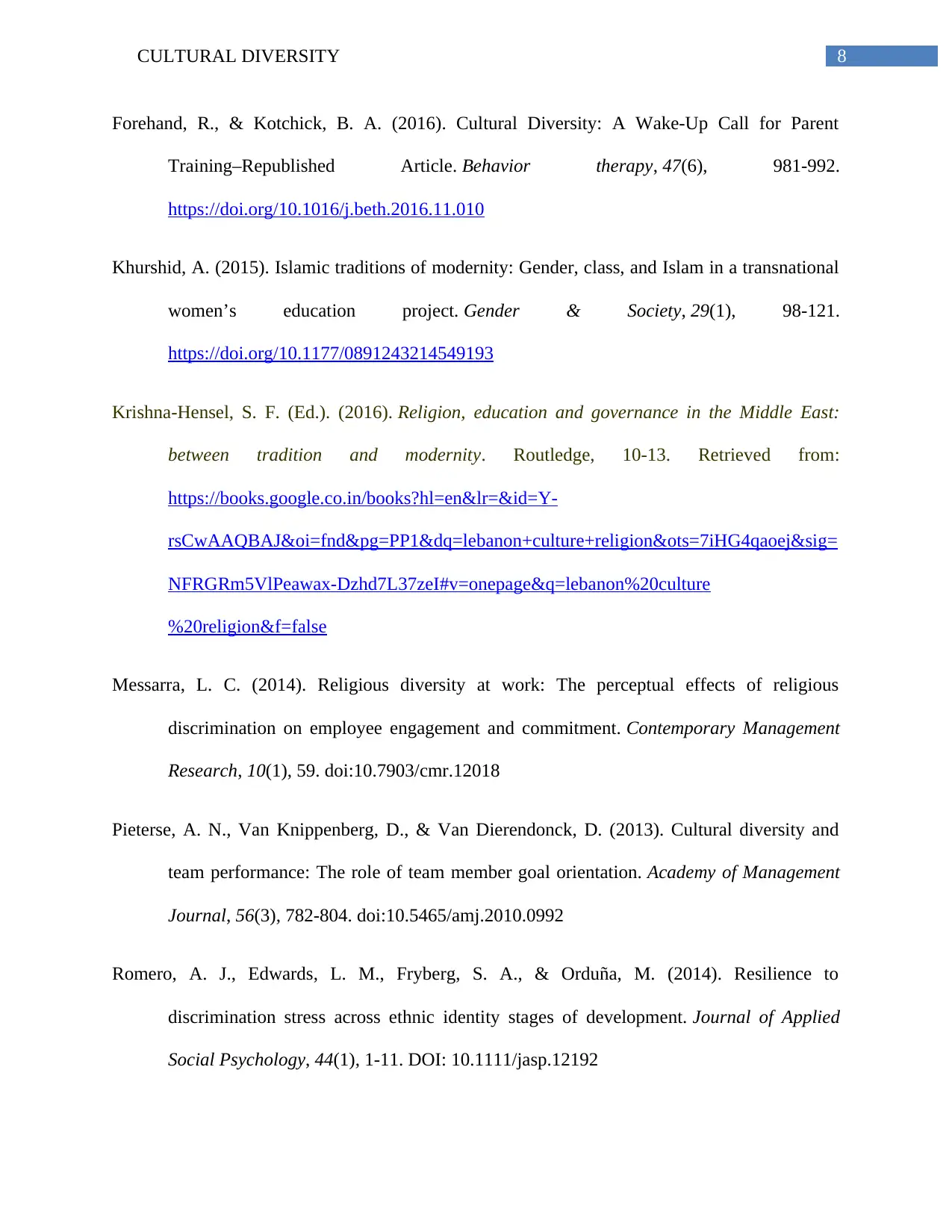
8CULTURAL DIVERSITY
Forehand, R., & Kotchick, B. A. (2016). Cultural Diversity: A Wake-Up Call for Parent
Training–Republished Article. Behavior therapy, 47(6), 981-992.
https://doi.org/10.1016/j.beth.2016.11.010
Khurshid, A. (2015). Islamic traditions of modernity: Gender, class, and Islam in a transnational
women’s education project. Gender & Society, 29(1), 98-121.
https://doi.org/10.1177/0891243214549193
Krishna-Hensel, S. F. (Ed.). (2016). Religion, education and governance in the Middle East:
between tradition and modernity. Routledge, 10-13. Retrieved from:
https://books.google.co.in/books?hl=en&lr=&id=Y-
rsCwAAQBAJ&oi=fnd&pg=PP1&dq=lebanon+culture+religion&ots=7iHG4qaoej&sig=
NFRGRm5VlPeawax-Dzhd7L37zeI#v=onepage&q=lebanon%20culture
%20religion&f=false
Messarra, L. C. (2014). Religious diversity at work: The perceptual effects of religious
discrimination on employee engagement and commitment. Contemporary Management
Research, 10(1), 59. doi:10.7903/cmr.12018
Pieterse, A. N., Van Knippenberg, D., & Van Dierendonck, D. (2013). Cultural diversity and
team performance: The role of team member goal orientation. Academy of Management
Journal, 56(3), 782-804. doi:10.5465/amj.2010.0992
Romero, A. J., Edwards, L. M., Fryberg, S. A., & Orduña, M. (2014). Resilience to
discrimination stress across ethnic identity stages of development. Journal of Applied
Social Psychology, 44(1), 1-11. DOI: 10.1111/jasp.12192
Forehand, R., & Kotchick, B. A. (2016). Cultural Diversity: A Wake-Up Call for Parent
Training–Republished Article. Behavior therapy, 47(6), 981-992.
https://doi.org/10.1016/j.beth.2016.11.010
Khurshid, A. (2015). Islamic traditions of modernity: Gender, class, and Islam in a transnational
women’s education project. Gender & Society, 29(1), 98-121.
https://doi.org/10.1177/0891243214549193
Krishna-Hensel, S. F. (Ed.). (2016). Religion, education and governance in the Middle East:
between tradition and modernity. Routledge, 10-13. Retrieved from:
https://books.google.co.in/books?hl=en&lr=&id=Y-
rsCwAAQBAJ&oi=fnd&pg=PP1&dq=lebanon+culture+religion&ots=7iHG4qaoej&sig=
NFRGRm5VlPeawax-Dzhd7L37zeI#v=onepage&q=lebanon%20culture
%20religion&f=false
Messarra, L. C. (2014). Religious diversity at work: The perceptual effects of religious
discrimination on employee engagement and commitment. Contemporary Management
Research, 10(1), 59. doi:10.7903/cmr.12018
Pieterse, A. N., Van Knippenberg, D., & Van Dierendonck, D. (2013). Cultural diversity and
team performance: The role of team member goal orientation. Academy of Management
Journal, 56(3), 782-804. doi:10.5465/amj.2010.0992
Romero, A. J., Edwards, L. M., Fryberg, S. A., & Orduña, M. (2014). Resilience to
discrimination stress across ethnic identity stages of development. Journal of Applied
Social Psychology, 44(1), 1-11. DOI: 10.1111/jasp.12192
⊘ This is a preview!⊘
Do you want full access?
Subscribe today to unlock all pages.

Trusted by 1+ million students worldwide
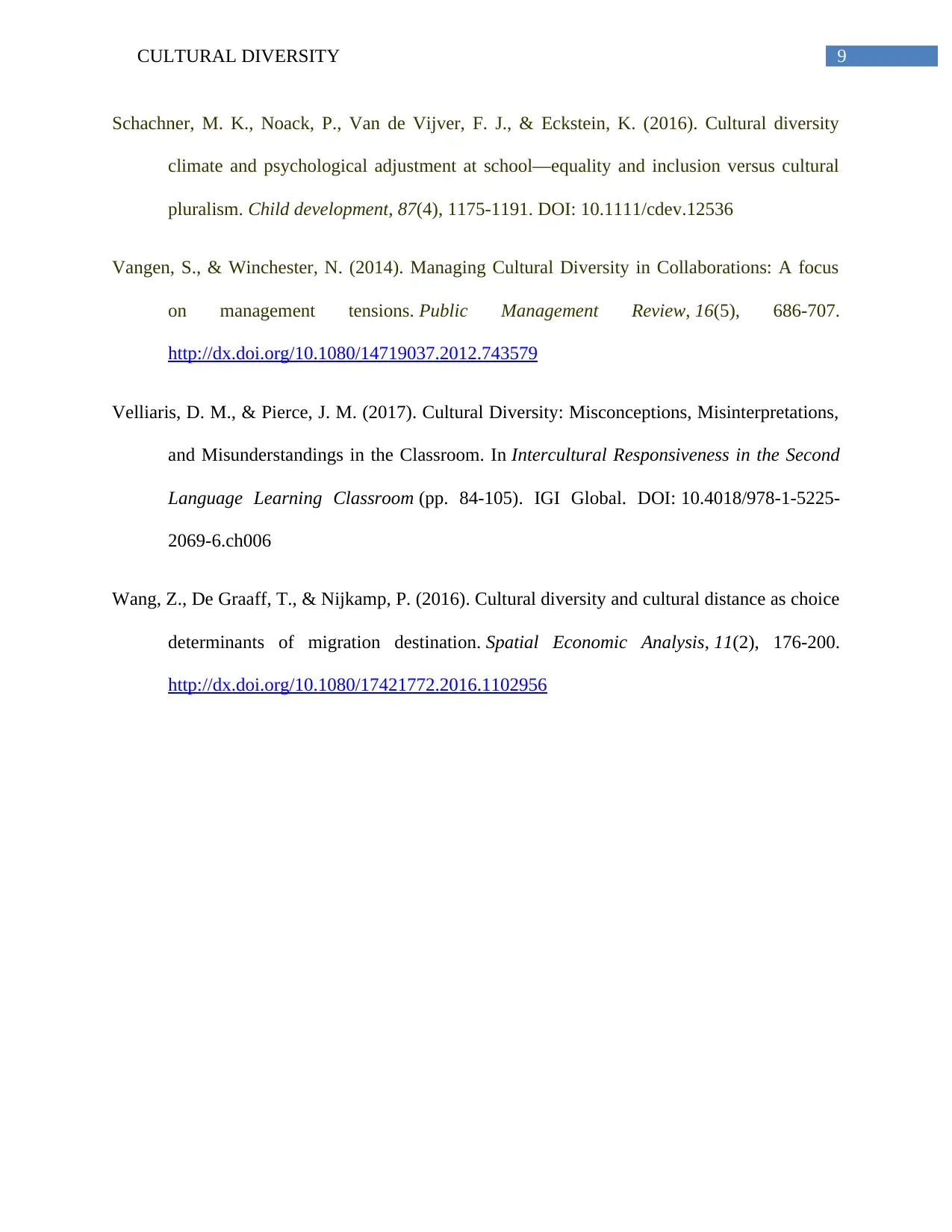
9CULTURAL DIVERSITY
Schachner, M. K., Noack, P., Van de Vijver, F. J., & Eckstein, K. (2016). Cultural diversity
climate and psychological adjustment at school—equality and inclusion versus cultural
pluralism. Child development, 87(4), 1175-1191. DOI: 10.1111/cdev.12536
Vangen, S., & Winchester, N. (2014). Managing Cultural Diversity in Collaborations: A focus
on management tensions. Public Management Review, 16(5), 686-707.
http://dx.doi.org/10.1080/14719037.2012.743579
Velliaris, D. M., & Pierce, J. M. (2017). Cultural Diversity: Misconceptions, Misinterpretations,
and Misunderstandings in the Classroom. In Intercultural Responsiveness in the Second
Language Learning Classroom (pp. 84-105). IGI Global. DOI: 10.4018/978-1-5225-
2069-6.ch006
Wang, Z., De Graaff, T., & Nijkamp, P. (2016). Cultural diversity and cultural distance as choice
determinants of migration destination. Spatial Economic Analysis, 11(2), 176-200.
http://dx.doi.org/10.1080/17421772.2016.1102956
Schachner, M. K., Noack, P., Van de Vijver, F. J., & Eckstein, K. (2016). Cultural diversity
climate and psychological adjustment at school—equality and inclusion versus cultural
pluralism. Child development, 87(4), 1175-1191. DOI: 10.1111/cdev.12536
Vangen, S., & Winchester, N. (2014). Managing Cultural Diversity in Collaborations: A focus
on management tensions. Public Management Review, 16(5), 686-707.
http://dx.doi.org/10.1080/14719037.2012.743579
Velliaris, D. M., & Pierce, J. M. (2017). Cultural Diversity: Misconceptions, Misinterpretations,
and Misunderstandings in the Classroom. In Intercultural Responsiveness in the Second
Language Learning Classroom (pp. 84-105). IGI Global. DOI: 10.4018/978-1-5225-
2069-6.ch006
Wang, Z., De Graaff, T., & Nijkamp, P. (2016). Cultural diversity and cultural distance as choice
determinants of migration destination. Spatial Economic Analysis, 11(2), 176-200.
http://dx.doi.org/10.1080/17421772.2016.1102956
1 out of 10
Related Documents
Your All-in-One AI-Powered Toolkit for Academic Success.
+13062052269
info@desklib.com
Available 24*7 on WhatsApp / Email
![[object Object]](/_next/static/media/star-bottom.7253800d.svg)
Unlock your academic potential
Copyright © 2020–2025 A2Z Services. All Rights Reserved. Developed and managed by ZUCOL.




